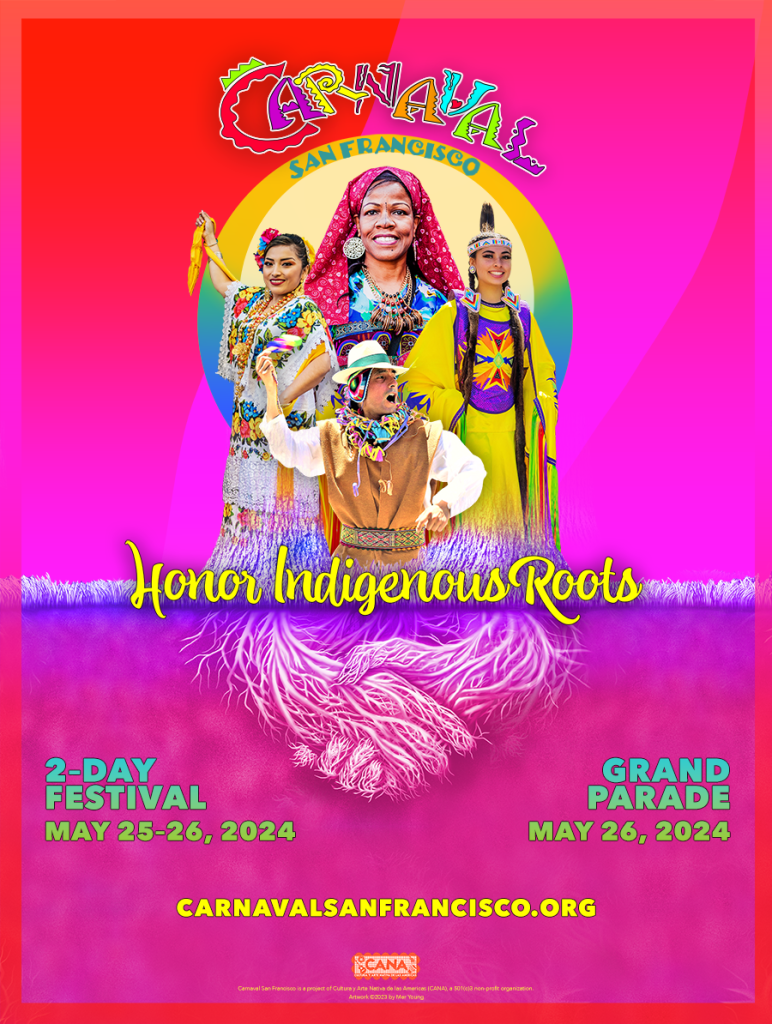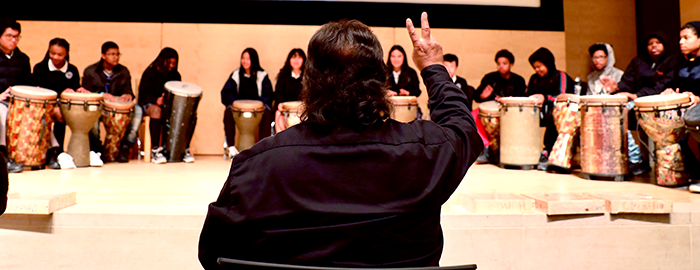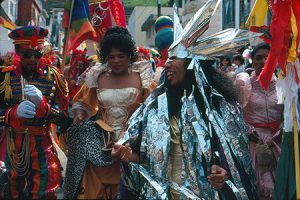Carnaval San Francisco cultivates and celebrates the diverse Latin American, Caribbean and African Diasporic roots of the Mission District and the San Francisco Bay Area. We accomplish our mission through dance, music, the visual arts and by creating spaces for community learning, school–based education, and advocacy.
Now in its fourth decade of celebration, Carnaval San Francisco has been an opportunity for many cultures to come together in one spirit to share their creative expression.
Come celebrate with us at our FREE 2–day family festival in San Francisco’s Mission District where we will showcase the very best Latin American and Caribbean cultural arts and traditions. Carnaval San Francisco is the largest multi–cultural celebration on the West Coast.
Carnaval San Francisco, the largest multicultural festival in the West Coast, is a project that CANA organizes, with the goal of educating people on the Latino, Caribbean and African Diasporic traditions of the Mission District and the San Francisco Bay Area. We accomplish our mission through dance, music, the visual arts and by creating spaces for community learning, school–based education, and advocacy.
We envision a world where harmony and revelry unite all people and where Latin American, Caribbean, and African traditions and cultures are preserved and celebrated for generations to come.
We value:
Our interconnectedness through art and family
Strong, artisanal businesses in our community
Collaborative, cross–cultural relationships
The healing power of cultural connection, re–connection, and reclaiming
The intersection between art and activism
The importance of revelry in a spiritual context
The power of volunteerism

The Carnaval San Francisco theme for 2024 is “Honor Indigenous Roots.” The idea of honoring indigenous heritage has always been part of our Carnaval culture. For example, every Carnaval parade is started with a blessing ceremony from local Aztec dancers, complete with the burning of copal incense to spiritually cleanse the community, accompanied by traditional drumming and dance. This ceremony is rooted in pre-Columbian practices that still have relevance today.
Throughout the 45 years of Carnaval celebrations, many of the participating groups have chosen to represent themselves with themes steeped in the indigenous communities of Mexico, Central America, South America, United States, the Caribbean and Brazil. Proudly wearing regalia and folkloric clothing made by hand in the same techniques of their ancestors, Carnaval groups showcase the beauty of their native cultures with traditional song and dance. Their presentations tell the stories of preserving the rainforest, waterways, crops, and keeping Pachamama (Mother Earth) in balance. Some of the dances depict oppression of native people and the suffering they have endured from slavery and colonization.
The spirit of indigenous people around the world burns strong because they know how important it is for humanity to co-exist with all of creation–both animate and inanimate. In caring for creation, and by respecting its balance, one can truly say that one is honoring their indigenous roots. Indigenous peoples’ roots are connected to the soil from which they sprang. To protect and care for their lands is to honor their cultures, languages, histories, and ancestral ways.
We honor their histories by educating ourselves about their heritage, acknowledging the impact of colonialism, and supporting indigenous-led initiatives both locally and internationally. As allies, we listen without reinterpreting what we hear from indigenous people. We must listen with the intention of learning, and not wanting to be the solution to their struggles. Only then can we amplify their voices and advocate for their rights.
To stand with indigenous people is to wholeheartedly acknowledge and respect their agency, self-determination and wisdom. Their journey is our journey because we all share the same Mother Earth and the need to protect her people and resources.
Artist: Mer Young
Carnaval San Francisco acknowledges that we are on the unceded ancestral homeland of the Ramaytush Ohlone who are the original inhabitants of the San Francisco Peninsula. As the indigenous stewards of this land and in accordance with their traditions, the Ramaytush Ohlone have never ceded, lost nor forgotten their responsibilities as the caretakers of this place, as well as for all peoples who reside in their traditional territory. As guests, we recognize that we benefit from living and working on their traditional homeland. We wish to pay our respects by acknowledging the ancestors, elders and relatives of the Ramaytush Community and by affirming their sovereign rights as First Peoples.
Aho to all my relations. Él Es Dios.
Our Grand Parade boasts a 60–contingent lineup, with over 3,000 artists representing the cultural heritages of Brazil, Mexico, Panama, Bolivia, Cuba, Peru, Puerto Rico, Nicaragua, Colombia, Trinidad & Tobago, Guatemala, El Salvador, and more to participate, televised by CBS. The Grand Parade covers 20 blocks in San Francisco’s historic Latino Cultural District in the Mission.
Our FREE two–day Festival covers 17 blocks in the Mission District, with five main stages, 50 local performing artists, and 400 vendors. The festival includes international food, dancing, sampling sites and entertainment for families, couples and friends of all ethnic, social and economic backgrounds.
In the 46–year history of our Festival, we have welcomed luminaries like Celia Cruz, Santana, the Neville Brothers, Tito Puentes, Luis Enrique, Poncho Sanchez, Los Lonely Boys, Oscar D’León, La India, and Los Tigres del Norte. The two-day celebration is a cultural explosion with free admission for the community. With an attendance rate of over 400,000 people every year, Carnaval San Francisco is the largest multicultural celebration in California.
While the festival is free to the public, donations are highly encourated.
 The Carnaval San Francisco Cultural Arts and Health Education Program was inaugurated as a pilot program at Flynn School in the Mission District in 2002. Flynn’s demographics included 68% Latinos (many being English Language Learners) and 16% African Americans.
Working with numerous teachers, CSF offered drumming and dance classes at Flynn seeking to increase student involvement in the arts and to prepare students to participate in the 2002 Carnaval Parade. As the program progressed, parents became involved in costume making, float building and volunteering for the program. Teachers reported that parents who had rarely visited their child’s school before became enthusiastic participants in the Carnaval SF education project. Since 2002, Carnaval has presented the program classes in 13 schools, serving over 9,000 students.
The Carnaval San Francisco Cultural Arts and Health Education Program was inaugurated as a pilot program at Flynn School in the Mission District in 2002. Flynn’s demographics included 68% Latinos (many being English Language Learners) and 16% African Americans.
Working with numerous teachers, CSF offered drumming and dance classes at Flynn seeking to increase student involvement in the arts and to prepare students to participate in the 2002 Carnaval Parade. As the program progressed, parents became involved in costume making, float building and volunteering for the program. Teachers reported that parents who had rarely visited their child’s school before became enthusiastic participants in the Carnaval SF education project. Since 2002, Carnaval has presented the program classes in 13 schools, serving over 9,000 students. The Origin of the Origin
– by Willy Lizágarra

On February 25th, 1979, a windy, cold and rainy Sunday in San Francisco, about three hundred drummers and dancers, dressed in multifarious colors and shapes, paraded around Precita Park in the Mission District.
Perhaps for the uninformed passerby, it all seemed like a crazy, “hippie,” let’s-dance-half-naked-in-the-park event. For the revelers, however, it was the culmination of many months of planning and rehearsing carnival in a city that until then didn’t have one—and now can boast of hosting, if not the biggest, certainly the most diverse carnival parade in the entire country, if not the world.
Continue reading this article on foundsf.org.
Photo by Lou Dematteis
KPOO’s Harrison Chastang Talks to Carnaval E.D. Rodrigo Duran-Mardi Gras & More
BNN: San Francisco’s Carnaval Festival Season Begins: A Mardi Gras Cele… (bnnbreaking.com)
For media inquiries, please contact:
De Alba Communications
Victoria Sanchez De Alba
(650) 270-7810
Jackie Wright
(415) 525-0410
For partnership opportunities, contact Rodrigo Duran, Executive Director at (415) 691–1147 or via email at rodrigo@carnavalsf.org